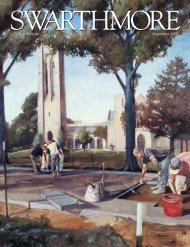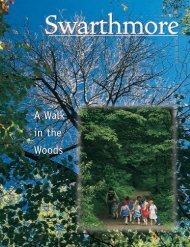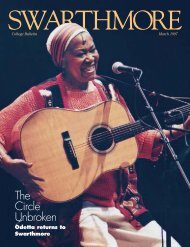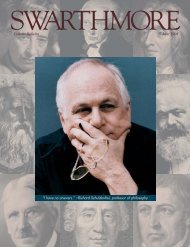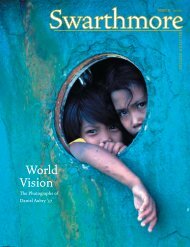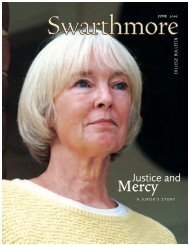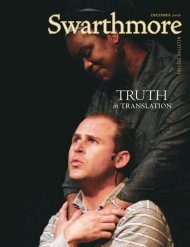ooks + artsRonald Dworkin’81, Artificial Happiness:The DarkSide of the NewHappy Class, Carroll& Graf,2006. The authorinvestigates therole of doctors intreating everydayunhappiness, theconflicts thathave arisen within the medical profession asa result, and the competition between medicineand religion over control of the humanmind and the definition of spirituality.Max Mulhern ’84, Wind Root, 2006. Taking the geometriclanguage of weather maps, the artist, for whom weatherhas been a natural obsession since childhood, abstractstheir stark symbols to create a world peopled with ragingweather monsters and whimsical weather trees. TheGalérie Artemisia in Paris exhibited Mulhern’s works fromMarch 7 to April 1.Thomas Hammond ’69, Chris Bonneau,and Reginald Sheehan, Strategic Behavior andPolicy Choice on the U.S. Supreme Court, StanfordUniversity Press, 2005. This book providesa comprehensive and integrated modelof how strategically rational Supreme Courtjustices should be expected to behave in allfive stages of the Court’s decision-makingprocess.Josef Joffe ’65, Überpower: The Imperial Temptationof America, W.W. Norton & Co., 2006.Mixing military history and diplomaticanalysis, the author offers an assessment ofthe United States as an unchallenged globalpower and the burdens that accompany itssingular standing. (Seeexcerpt on p. 12)D.H. Kerby ’86, It FellFrom the Sky, It Must beOurs: A Poem for Peace withJustice, Blitz Publications,2006. This personal andself-questioning poemgives authentic snapshotsof our chaotic world, fromthe streets of Jerusalem,Frankfurt, Managua, andPort-au-Prince to thepressroom of the UnitedNations.Susan Munch ’67, OutstandingMosses & Liverwortsof Pennsylvania andNearby States, SusanMunch, 2006. Withdetailed color photographs,this first colorfield guide for mosses inthe mid-Atlantic regionallows for easy identification—withoutusing amicroscope—of many ofthe most common andstriking mosses and liverworts.Cesare Lombroso, CriminalMan (translated and witha new introduction byMary Gibson and NicoleHahn Rafter ’62), DukeUniversity Press, 2006.Using excerpts from allfive editions of Lombroso’s1876 classic of criminology,this annotated translation along with itsintroduction show the progression of theauthor’s thought and his positivisticapproach to understanding criminal behavior.Jeffrey Shandler’78, Adventures inYiddishland, Universityof CaliforniaPress, 2006.Tracking thetransformation ofYiddish since theHolocaust, fromthe language ofJewish daily lifeto what he calls“a postvernacularlanguage ofdivers and expanding symbolic value,”Shandler draws on language learning, literarytranslation, performance, and materialculture as manifested in children’s books,board games, summer camps, klezmermusic, cultural festivals, language clubs,Web sites, cartoons, and collectibles.Yankev Glatshteyn, Emil and Karl (translatedby Jeffrey Shandler), Roaring Brook Press,2006. In a new translation of this 1940novel for young readers about two boys—one Jewish, the other Austrian—during theearly days of the Holocaust period, Shandlerplaces the novel in its historical context andexplains the author’s approach to his subject.Elisabeth Sussman and Fred Wasserman’78, with essays by Yve-Alain Bois and MarkGodfrey, Eva Hesse: Sculpture, Yale UniversityPress, 2006. In a collection of essays, thiswork provides a rare opportunity to look atHesse’s artistic achievement within the historicalcontext of her life through familydiaries and photographs. It was publishedin conjunction with the May 12 to Sept. 17exhibit of the same name organized by TheJewish Museum, New York City, whereWasserman is the Henry J. Leir curator.Let the Bulletin know about your latestscholarly, literary, visual, theatrical, cinematic,or other artistic effort at bulletin@swarthmore.eduor by sending press releases, photos,or review copies to Books & Arts, SwarthmoreCollege Bulletin, 500 College Avenue,Swarthmore PA 19081.60 : swarthmore college bulletin
profileArtful Energy 2ROBERT STORR ’72: CURATOR, ARTIST, TEACHER, CRITIC, HISTORIAN, AND WRITERAfter curating the 2007 Venice Biennale, Robert Storr will turnhis attention to expanding Yale’s art program.The staccato rhythm of Robert Storr’s fast-paced words and hisenergetic enthusiasm reveal a man who has retained the“unbounded energy and creativity” that William R. Kenan Jr., ProfessorEmerita of Art History T. Kaori Kitao saw in him as a student.As he leads our phone conversation full-speed ahead detailing oneproject after another, it becomes clear how this Chicago native hasachieved so much since graduating from Swarthmore in 1972.Yale President Richard Levin’s announcement of Storr’s appointmentas dean of the University’s School of Art confirms that Storr’sintense drive has not waned over time. “Rob Storr is deeply knit intothe contemporary art world and has an interest in educating the artistof the future,” Levin said.In New Haven, Storr is settling into his newest role at one ofthe most selective art schools in North America and spending thefall learning the ropes. Yet, before he directs his attention to expandingand fine tuning Yale’s program—one of the few institutionswhere art-making is the central focus—he will take an agreed-uponleave of absence during the spring semester to curate and direct the2007 Venice Biennale.HERBERT LOTZStorr explains that the Biennale, which began in 1895, is the oldestinternational exhibition of visual art and the baseline for all others.As the first American invited to hold this position, he regardsthe offer as “a huge opportunity that I couldn’t turn down.”Three classmates who have followed the path of Storr’s careeroffer startlingly similar descriptions of him—intellectual, intense,thoughtful, and decent, a man of energy and ideas. Peter Canby,senior editor at The New Yorker, describes Storr as “a high octanemix” of these qualities. To Saralinda Bernstein Lichtblau, managerof the school programs at the Hudson River Museum, Storr “was alarger-than-life figure, romantic, with a flippant shock of blondehair.” Carola Sullam Sheperd, remembers that “Rob had a certaintrademark look—classic white shirt with casually rolled-upsleeves—and a wide circle of friends, connected to him throughaesthetic interests or radical politics.”Storr grew up in a family of academics. Both parents graduatedfrom Swarthmore—Richard Storr in 1937 and Virginia Vawter Storrin 1938. He studied French literature and history as an undergraduate,but, as he told an Arts and Antiques writer in 1996, he was always“drawing quietly.” In 1978, he earned a master of fine arts degreefrom the School of the Art Institute of Chicago.When Storr was at the College, Swarthmore’s art curriculum wasmuch different—there were studio art courses, but an art major wasnot available. Looking back, he recalls the lack of art options andthe conservatism of the institution. As a result of those limitations,he “was inspired to find out what I’d been missing.” He attributeshis great interest in knowing how a piece of art is made, not justhow good it is, to two art history professors—Hedley Rhys andRobert Walker, both now deceased—with whom he spent manyhours talking about art. Sheperd recalls that she and Storr had “ashared admiration for the wit, wisdom, and verve of Rhys.”While he serves as Yale’s dean, Storr will continue as consultingcurator of modern and contemporary art at the Philadelphia Museumof Art. He is teaching one last class at the Institute of Fine Artsat New York University this fall and will see his current graduatestudents through to completion of their theses. And he will continueworking on several books and creating art.From 1990 to 2002, Storr was a curator and then senior curatorof painting and sculpture at the Museum of Modern Art (MoMA),where he prepared major exhibitions. Storr’s paintings have beenexhibited in New York galleries, and his work is in the collections ofthe Nelson-Atkins Museum of Art and MoMA.Reflecting on his hectic pace, Storr says: “It allows me to do whatinterests me. I have high powers of concentration but no desire atall to be a specialist in any one area to the exclusion of others. If Ihave brought people’s attention to art and ideas that they would nothave been aware of otherwise, then I have done my job.”—Susan Cousins Breen62 : swarthmore college bulletin
- Page 1: americathe überpower
- Page 7: Swarthmore’sDistinctive Invitatio
- Page 10 and 11: collectionELEFTHERIOS KOSTANSA Sele
- Page 12 and 13: collectionArboretum HonoredIN APRIL
- Page 15 and 16: WHEN ONE NATION DOMINATES THEWORLD,
- Page 17 and 18: Europe, mourning the loss of its ce
- Page 19 and 20: planetary clout, its location athwa
- Page 21 and 22: A s k t h e{ R i g h t }Q u e s t i
- Page 23 and 24: Korea, this guy served in Vietnam,
- Page 26 and 27: Fiedler, however, plans to become a
- Page 28 and 29: The Evolution of HonorsSince 1922,
- Page 30 and 31: into a 10-minute, after-dinner pres
- Page 32 and 33: ANDY DRUCKER ’06Anna Torres (abov
- Page 34 and 35: "MURALS CAN TRANSFORMNOT ONLY THE W
- Page 36 and 37: alumni weekend2006Photographs by Ji
- Page 38 and 39: connectionsRECENT EVENTSBoston: In
- Page 40 and 41: class notesJIM GRAHAMKen and Anne M
- Page 42 and 43: ooks + artsEasy,Simple,andFreeboA C
- Page 46 and 47: profileSuds and ScienceBIOLOGIST GR
- Page 48 and 49: After 10 days on the farm, Swim’s
- Page 50 and 51: GEORGE WIDMAN



